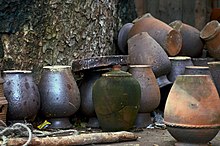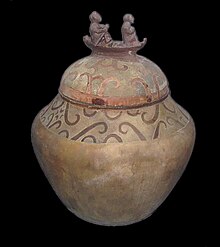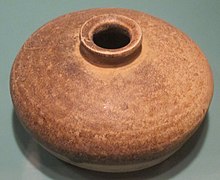|
Philippine ceramics
 Philippine ceramics refers to ceramic art and pottery designed or produced as a form of Philippine art.  History  Traditional pot-making in certain areas of the Philippines would use clay found near the Sibalom River. Molding the clay required the use of wooden paddles, and the clay had to be kept away from sunlight.[1] Native Filipinos created pottery since 3500 years ago.[1] They used these ceramic jars to hold the deceased.[2] Other pottery used to hold remains of the deceased were decorated with anthropomorphic designs. These anthropomorphic earthenware pots date back to 5 BC. - 225 A.D and had pot covers shaped like human heads.[2] Filipino pottery had other uses as well. During the Neolithic period of the Philippines, pottery was made for water vessels, plates, cups, and for many other uses.[3] Kalinga Pottery [4] Ceramic vessels of Kalinga are divided into three types: rice cooking (ittoyom), vegetable/meat cooking (oppaya), and water storage (immosso) pots. According to Skibo, the rice cooking pots are usually larger, thinner and have a smaller opening than vegetable/meat pots. On the other hand, water storage pots have an average and uniform size and a smaller neck size. Except for water storage pots, which have a uniform size, the other two kinds can come in three different sizes, large, medium and small. Although this is true in some cases, another larger type of vegetable/meat pot and smaller water storage pot exists. • Manufacture of Kalinga potteries  The first step in the manufacture of pots is the acquisition of the starting material, clay. The clay is then pounded, added with enough amount of water, to reach the wanted flexibility, and placed in a rotating plate. Using the hand-modeling and coil-and-scrape techniques, the height, thickness and shape of the pot is established. After this, the rim is designed by placing a wet rag on top of it and then rotating it in the other direction. Furthermore, scraping of the walls can also be done if the walls produced are too thick. The pot, after the modeling stage, is then dried for a short period of time before the base is shaped. Also, after additional heating, small amounts of clay are added inside and outside the clay to maintain the evenness of the surface. A polishing step can also be done through the use of a polishing stone. In some cases, pots are also painted with red hematite paint for some stylized design. Pottery Functions [4] Pots are ceramic vessels that are made by molding clay into its wanted shape and then leaving it in an environment with an elevated temperature thereby making it solid and sturdy. It is widely recognized as one of better tools that humans invented since it managed to store the surplus of food Neolithic humans gathered. In the book Pottery Function: A Use-Alteration Perspective, the author, James Skibo, reasoned out why the use of pots is far more advantageous than baskets and other organic containers. He said that since potteries are commonly made in clay, heat has little to none effect on the container, and its contents, and that it protects the food from moisture and pests. Furthermore, its range of storable contents is far wider than baskets and animal skins since it can store both liquid and dry goods. Also, Rice, in his book Pottery Analysis, classified ceramic vessels into 17 categories depending on various factors that concern the use and production of the tool. One of these is the content wherein he further divided a type of pot into four depending on the state (liquid or solid) and temperature (hot or cold) of the food inside it. He also said that a ceramic has three main uses. These three are storage, processing, and transfer. Based from these three uses that Rice gave, Skibo further characterized the usage of ceramic vessels by dividing the tool's function into two, (1) intended use and (2) actual use. Intended use, as the name implies, is how the tool's supposed to be used. This is the basis of the manufacture of the ceramic vessel since the form follows the function. On the other hand, actual use is how the tool was used. This sometimes disregards the pot's form as long it can do a specific function. Kalinga Pottery and its Uses [4]  In Kalinga, ceramic vessels can be used for two situations: daily life use and ceremonial use. Daily life uses include the making of rice from the pots and the transfer of water from nearby water bodies to their homes. • Determining actual function of Kalinga pots As said, a pottery sometimes has a different actual use than intended use. This is the reason why when archaeologists study the function of a pottery, they tend to focus on how the tool was actually used. They do this by studying the alterations that the pottery has. These alterations, accretion and attrition, are commonly the abrasions and scratches on the vessel. In Skibo's study of Kalinga potteries functions, he relied on three main tests, namely (1) dissolved residue, (2) surface attrition and (3) carbon deposition.
Iron Age pottery [5] There are three major complexes in Philippine Iron Age according to Solheim, Kalanay, Novaliches and Bau pottery complexes. Kalanay pottery complex pertains to Beyer's Early Iron Age pottery of the Visayan Islands found in Negros and Mindoro; novaliches pottery complex to Beyer's Early Iron Age pottery from Rizal province. Bau pottery, on the other hand, does not fit into the two previous complexes and could correspond instead to the Late Iron Age pottery. Kalanay Pottery Complex [5] The type site of the Kalanay pottery complex is the Kalanay Cave found in Masbate. From this site, the pottery is further subdivided into pottery types Kalanay and Bagupantao. Specific varieties of decoration are as follows:
Kalanay complex pottery can be divided into 16 groups according to Solheim.
Bau Pottery Complex [5] It has less variation in both form and decoration compared to the Kalanay pottery complex. Specific varieties of decoration are as follows:
In terms of forms:
Novaliches Pottery Complex [5]  Most of Novaliches pottery can be distinguished from Bau pottery and Kalanay pottery. While it shares form and decoration with Kalanay pottery, it contains more variability compared to Bau pottery. According to Solheim (2002), “it is the most sophisticated pottery that has yet been found in the Philippines” Novaliches pottery can be diagnosed by its form being a shallow bowl with a high right-foot. The shallow bowl is generally plain but the feet are highly decorated. Majority of Novaliches pottery were well polished. The form is so symmetrical that it looks as if it was made in a potter wheel, however, examinations showed that it wasn't. Specific varieties of decoration are as follows:
Vessel forms are as follows:
Kalanay Cave Site [5] The Kalanay cave site is a small burial cave. It is located at the northwest coast of Masbate. • Kalanay Pottery
• Kalanay Incised
• Kalanay slipped
Bagupantao Pottery [5] • Bagupantao Plain
• Bagupantao Impressed
• Bagupantao Painted
• Extraneous Pottery - Three vessels that did not belong to the Bagupantao and Kalanay style were also found. First pot
Second pot
Third pot
In Japan, pottery from Luzon became especially esteemed and was used in Japanese tea ceremony as shimamono. See also
References
External links
|